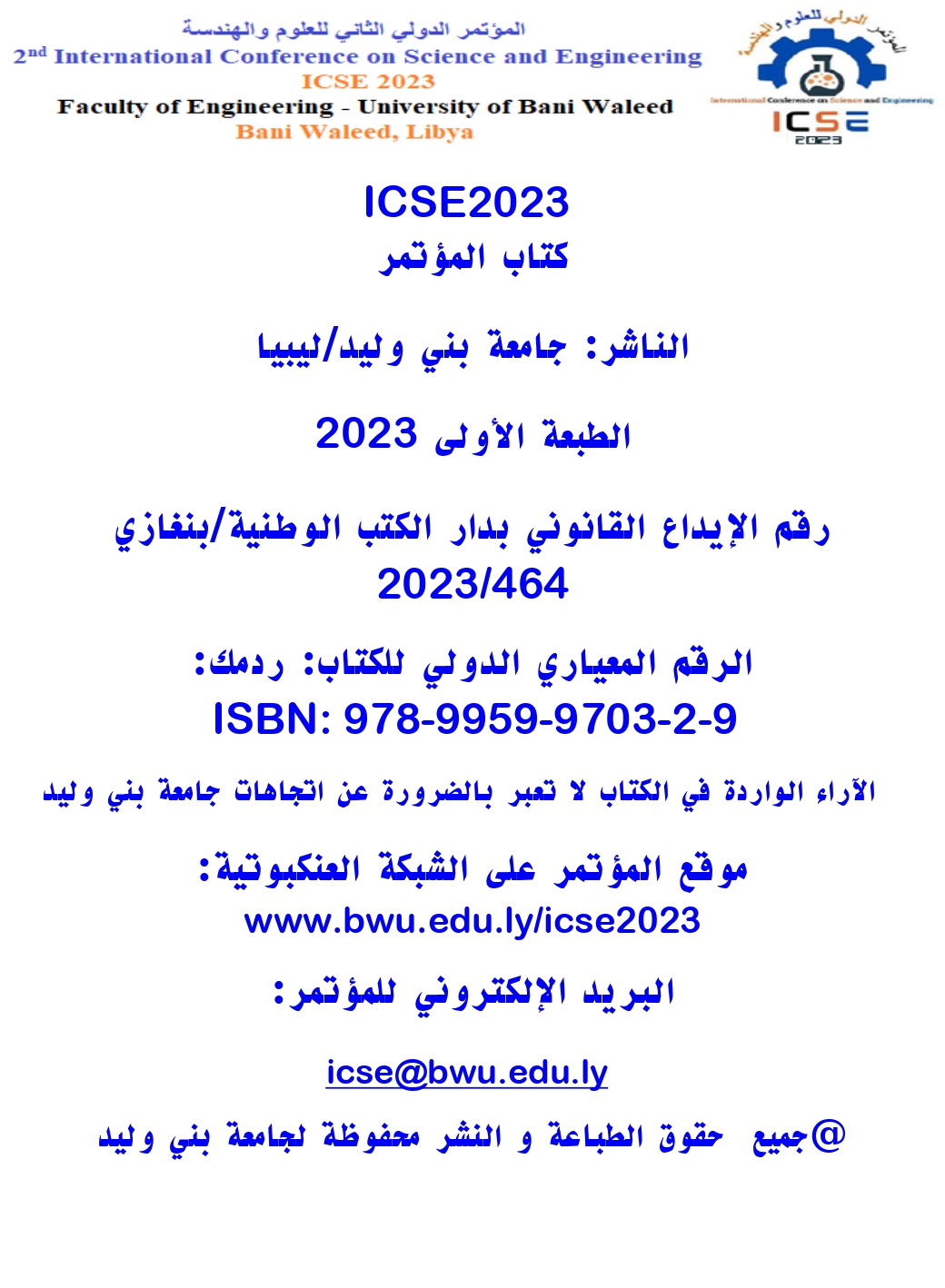Prevalence of Premature Loss of Primary Teeth among School-children Aged (6-10 Years Old) in the Libyan City of Bani Waleed and Assessment of Parental Knowledge and awareness towards Space Maintainer
DOI:
https://doi.org/10.58916/jhas.v8i3.487الكلمات المفتاحية:
الانجليزيةالملخص
The premature loss of primary teeth is one of the most common dental problems affecting the growth and development of children’s teeth. It is often caused by dental caries. Premature loss of the primary teeth results in a loss in the length of dental arch and leads to malocclusion. Space Maintainers play an important role in managing the spaces created by the early loss of primary teeth. The use of space maintainers depends on parent’s awareness and knowledge towards space maintainers. The current study was goaled to define prevalence of premature loss of primary teeth among schoolchildren (6-10 years old) in the Libyan city of Bani Waleed, as well as, evaluating the awareness level of their parents toward space maintainers. A descriptive cross-sectional questionnaire-based study was conducted. The data were analyzed and summarized statistically using SPSS version 26.0. Chi-square test was carried out to detect correlation between variables. The results revealed that (55.1%) of the children suffered of premature loss of their teeth with no significant variation among the genders (P>0.05). The highest prevalence (16.4%) was recorded at the age of 7 years old. (70.5%) caused by dental caries. (82.40%) of parent’s respondents that they don’t know what is (SM) appliances and when used. This study demonstrated that, prevalence of premature loss of primary teeth among school-children was high, and the Knowledge of space maintainers among Bani Waleed parents is very less. So, dentists need to create awareness about space maintenance of primary teeth and preventive orthodontic.
التنزيلات
المراجع
Moyers RE. (1991), Ortodontia. 4th ed. Rio de Janeiro: Guanabara Koogan.
Rao, AK., Sarkar, S. (1999), Changes in arch length following premature loss of deciduous molars. J Indian Soc Pedo Prev Dent. 17:29-32.
Brothwell, DJ. (1997), Guidelines on the use of space maintainers following premature loss of primary teeth. J Can Dent Assoc. 63:753-766.
Al-Shahrani N, Al-Amri A, Hegazi F, Al-Rowis K, Al-Madani A, Hassan KS. (2015), The prevalence of premature loss of primary teeth and its impact on malocclusion in the Eastern Province of Saudi Arabia. Acta odontological Scand. 73(7):544-549. https://doi.org/10.3109/00016357.2014.939709.
Cavalcanti AL, Alencar CRBD, Bezerra P, Granville-Garcia AF. (2008), Prevalence of early loss of primary molars in school children in Campina Grande, Brazil. Pakistan Oral Dent J., 28(1):113.
AlMeedani LA, Al-Ghanim HZ, Al-Sahwan NG, AlMeedani SA. (2020), Prevalence of premature loss of primary teeth among children in Dammam city and parents' awareness toward space maintainers. Saudi J Oral Sci., 7:85-9. http://dx.doi.org/10.4103/sjos.SJOralSci_9_19.
Nagarajappa R, Kakatkar G, Sharda AJ, Asawa K, Ramesh G, Sandesh N. (2013), Infant oral health: Knowledge, attitude and practices of parents in Udaipur, India. Dent Res J (Isfahan). 10:659-65.
Kumari NR, Sheela S, Sarada PN. (2006), Knowledge and attitude on infant oral health among graduating medical students in Kerala. J Indian Soc Pedod Prev Dent., 24:173-6. https://doi.org/10.4103/0970-4388.28072.
Alshehri A, Nasim V. (2015), Infant oral health care knowledge and awareness among parents in Abha city of Aseer Region, Saudi Arabia. Saudi J Dent Res 6:98-101. https://doi.org/10.1016/j.sjdr.2015.01.001.
Borum MK, Andreasen JO. (1998), Sequelae of trauma to primary maxillary incisors. I. Complications in the primary dentition. Endodontics Dent Traumatol 14(1): 31–44. https://doi.org/10.1111/j.1600-9657.1998.tb00806.x.
Cardoso L, Zembruski C, Femandes DS, Boff IPV, Pessin V. (2005), Evaluation of prevalence of malocclusion in relation to premature loss of primary teeth. Pesq Bras Odontoped Clin Integr. 5:17-2.
Almedida Heilborn JC, Küchler EC, Fidalgo DS, et al. (2011), Early primary tooth loss: prevalence, consequence and treatment. Int J Dent 10(3):126-130.
Khanna P, Sunda S, Mittal S. )2015(, “Keep My Space”- A Review Article. International Journal of Oral Health Dentistry, Jan-March. 1(1):11-15.
Gideon H, Howard L. (2014), Premature loss of primary anterior teeth due to trauma– potential short- and long-term sequelae. Dental Traumatology. 30: 100–106. https://doi.org/10.1111/edt.12081.
Peter Schopf. (2003), Indication for and frequency of Early Orthodontic Therapy or Interceptive Measures. Journal of Orofacial Orthopedics. 649(3):186-200. https://doi.org/10.1007/s00056-003-0234-6.
Green J. (2015), Mind the gap: Overview of space maintaining appliances. Dent Nurs., 11:24‑7. http://dx.doi.org/10.12968/denn.2015.11.1.24.
Marwah, Nikhil. (2019), Textbook of Pediatric Dentistry, New Delhi | London | Panama: Jaypee Brothers Medical Publishers (P) Ltd.
Wo ng ML, Che Fatimah Awang, Ng LK, Norlian D,Rashidah Dato Burhanudin, Gere MJ. (2004), Role of interceptive orthodontics in early mixed dentition. Singapore Dent J., 26:10‑4.
Keski‑Nisula K, Hernesniemi R, Heiskanen M, Keski‑Nisula L,Varrela J. (2008), Orthodontic intervention in the early mixed dentition: A prospective, controlled study on the effects of the eruption guidance appliance. Am J Orthod Dentofacial Orthop, 133:254‑60. https://doi.org/10.1016/j.ajodo.2006.05.039.
Heilborn J, Kuchler E, Fidalgo T, Antunes L, Costa M. (2011), Early primary tooth loss: Prevalence, consequence, and treatment. Int J Dent., 10:10‑3.
Linjawi AI, Alajlan SA, Bahammam HA, Alabbadi AM, Bahammam MA. (2016), Space Maintainers: Knowledge and Awareness among Saudi Adult Population. J Int Oral Health. 8:733‑8.













